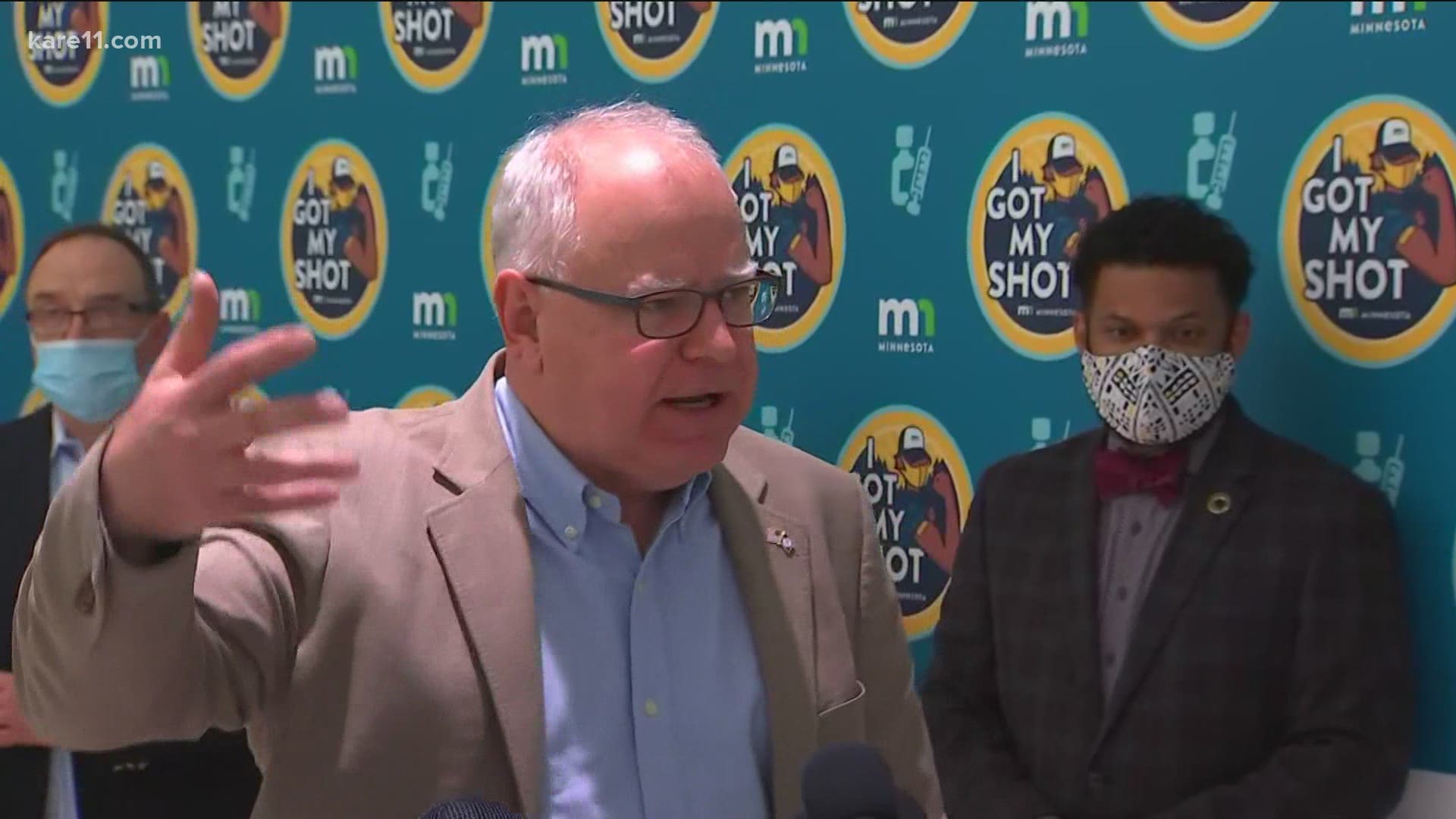ST PAUL, Minn. — Thursday, May 20
- MDH reports 874 new COVID cases, sixth consecutive day under 1,000
- Walz considers 'incentives' to boost stalling vaccination numbers
- MDH: Approximately 70% of Minnesota's COVID cases are B.1.1.7
- State Fairgrounds vaccine site to offer J&J shots next week
- Target, Hy-Vee and Home Depot end mask mandate for fully vaccinated customers, employees
11 a.m.
Data released Thursday by the Minnesota Department of Health (MDH) suggests that new COVID infections may be stabilizing a bit after a significant spike in mid-to-late April.
MDH recorded 874 new cases of the virus in the past day, bringing the state total to 597,052 since the start of the pandemic. It's the sixth consecutive day that single-day cases have been under the 1,000 mark. Those new cases are based on results from 31,604 tests (24,612 PCR, 6,992 antigen) processed in private and state labs.
Health experts consider a positive PCR test a confirmed COVID case, while a positive antigen test is considered probable.
Young adults remain the largest grouping of cases with those between 20 and 24 accounting for 57,726 infections and four deaths. Their counterparts ages 25 to 29 make up 52,858 cases and seven deaths.
Hennepin County reports the most COVID activity with 123,410 cases and 1,739 deaths, followed by Ramsey County with 51,792 cases and 881 deaths, Dakota County with 46,233 cases and 455 deaths, and Anoka County with 42,108 cases and 441 fatalities.
Cook County has recorded the least COVID activity with 167 cases and zero deaths.
After consecutive days of double digits fatalities dropped to eight, bringing Minnesota's total to 7,333. Of those deaths 4,396 (60%) are associated with assisted living or long-term care facilities. The virus has had the most deadly impact on those ages 85 to 89, with 1,332 deaths in just 6,732 cases.

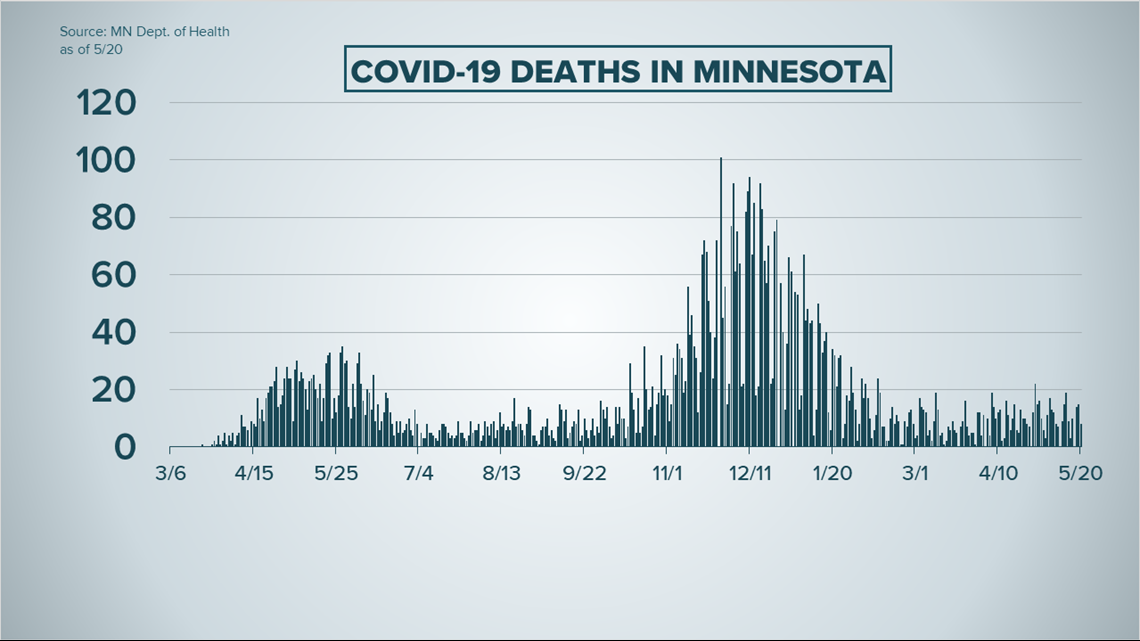
Minnesota's vaccination effort has likely passed the significant milestone of 5 million doses administered. As of Tuesday the state vaccine dashboard says 4,984,556 doses have gone into arms, and two additional days of unreported vaccinations, and numbers from a week of immunizations for 12- to 15-year-olds still out will likely push the state over the 5 million mark.
At this point 62.4% of eligible Minnesotans have received at least one dose of COVID vaccine (2,780,666 people) and of those, 2,410,545 have completed the shot sequence and are considered totally vaccinated (54.7%).

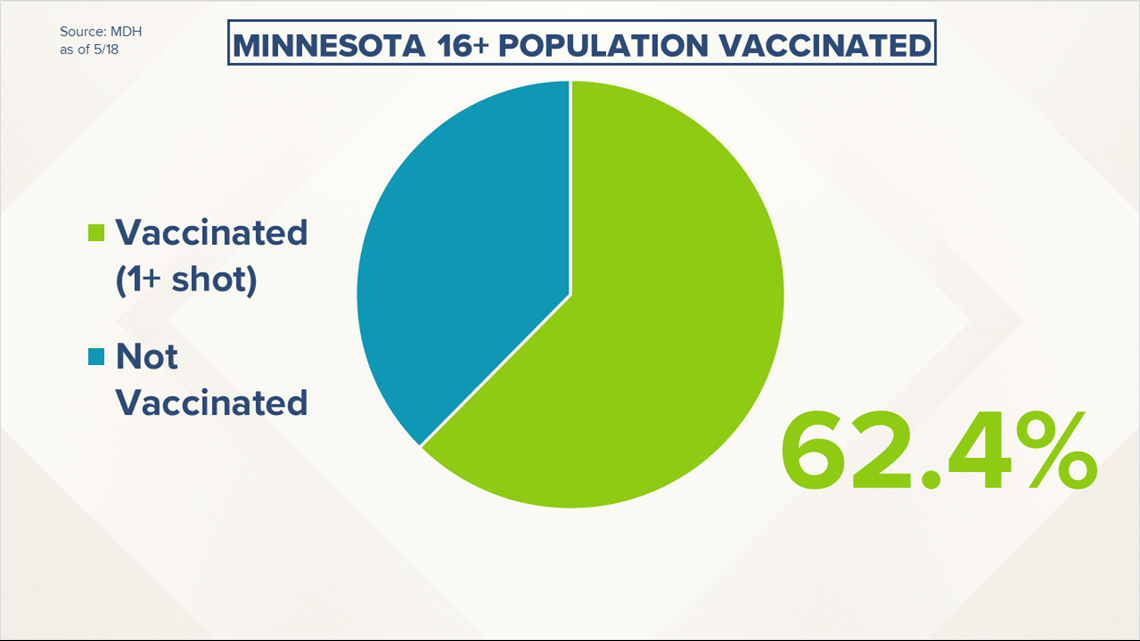
Daily COVID hospitalizations continue their slow drop, with 412 people being treated for the virus on an inpatient basis as of Wednesday, 109 of them in ICU. Total hospitalizations since COVID came to Minnesota are now at 31,642.
MDH says 582,480 people who tested positive for coronavirus have improved to the point they no longer require isolation.

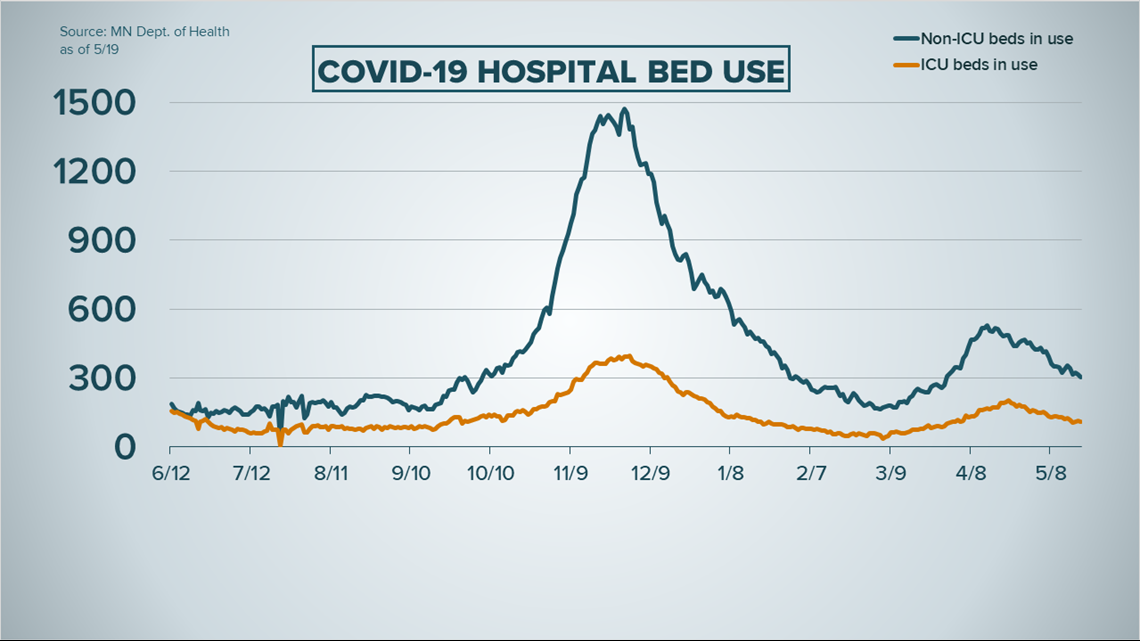
Wednesday, May 19
2:30 p.m.
The Minnesota Department of Health (MDH) held a media briefing Wednesday afternoon, saying that while most COVID-19 indicators are trending in the right direction, variants are still circulating in the state.
MDH Commissioner Jan Malcolm said the rate of new COVID admissions to Minnesota hospitals continues to decline, with 420 people currently hospitalized. The state's case activity is still above the high-risk threshold but has dropped 30% over the past week. Test positivity is now below the caution threshold, at 4.9%.
Vaccine progress has slowed significantly after the first initial push. Minnesota is nearing 62% of residents ages 16 and older who have had at least one dose.
“We now are measuring our progress in smaller increments, a couple of tenths of percent at a time, but we are still moving upwards," Malcolm said. "Not as quickly to be sure, but steadily.”
Malcolm said MDH's strategy is "to really push vaccine out deeper into the community” by partnering with local public health, using mobile units, and making the vaccine more available at routine points of health care and pharmacies.
She said the state is also working with summer events to host vaccine clinics.
“Just trying to get the vaccine to be extremely convenient for people, as well as continuing to educate and to address concerns that people have," Malcolm said.
One such easy access point is the community site at the Minnesota State Fairgrounds.
“For the next two weeks the state fair vaccination site is now offering appointments to receive the one dose, one-and-done Johnson and Johnson vaccine,” Malcolm said.
Anyone interested can sign up by using the state's Find My Vaccine tool.
“We are still kind of targeting ... to meet or beat July 1 for 70% of the 16 plus population,” Malcolm said. “We will be setting additional goals for specific subsets of the population as they are just becoming eligible, the 12-15 group.”
MDH Infectious Disease Director Kris Ehresmann also urged newly eligible pre-teens and teens to get vaccinated.
“It’s never been easier to get the vaccine and there are many options available to do this,” Ehresmann said.
She also clarified new guidance from the CDC and from Minnesota on masks, saying that until people are fully vaccinated, meaning two weeks out from their final shot, "It's important to use the protective measures that have been shown to work. That includes masking, social distancing and staying home when sick."
Ehresmann asked Minnesotans to remember there are communities, businesses and settings like public transportation that are still requiring masks.
“It’s important that these requirements be respected and followed," she said.
That's especially true in health care settings, Ehresmann said, where Minnesota's more vulnerable are still being treated.
“Wearing a mask regardless of your vaccination status when you are in a health care setting helps to protect those vulnerable populations,” she said. ”The virus is still out there in our community and is still very much a threat to anyone who is not vaccinated."
Ehresmann also reminded Minnesotans that there are still people out there who are not vaccinated, and people who cannot get vaccinated - including those under age 12.
“Anyone who is not fully vaccinated should continue to wear face coverings indoors and outdoors in crowds, large venues and certain other settings,” she said.
Dr. Ruth Lynfield, the state epidemiologist, joined the call to share information about monoclonal antibodies as a treatment for COVID-19. She said the FDA has approved two such treatments that can “prevent the need for hospitalization in people who have risk factors” if given early enough.
Minnesota has administered over 6,500 infusions since the state started receiving a supply last fall.
Eligibility has recently been expanded to include a much broader range of high-risk medical conditions, Lynfield said, including pregnant women and people over age 12 with some high-risk conditions. Treatment must be given within 10 days of symptom onset and works best as early as possible.
“We encourage all patients to get a COVID test as soon as they develop symptoms and talk to their providers about eligibility,” Lynfield said.
Patients can also get connected to COVID-19 treatment resources on the MDH website.
Lynfield said infusion costs are fully covered by Medicare.
Ehresmann gave an update on "breakthrough" COVID-19 infections in Minnesota, saying that 2,249 breakthrough cases have been reported so far out of more than 2 million people who have a complete vaccine series. That is about 0.1%. Ehresmann said these are more common in women, and the average age is 70 years old.
“Which would fit with the idea that as we age our immune systems are not quite as responsive,” she said.
No particular vaccine has been connected with these breakthrough infections, and Ehresmann said national studies indicate that the vaccine continues to show “high levels of effectiveness, as were seen in the clinical trials.”
There have been a number of breakthrough cases occurring 14-20 days after vaccination with the J&J shot, Ehresmann said, which suggests that people were exposed before they developed protection from the vaccine.
Dr. Lynfield said MDH researchers believe more than 70% of Minnesota COVID cases can now be attributed to the B.1.1.7 variant first identified in the United Kingdom. Because MDH is not "sequencing every specimen" to identify variants, it's hard to report an exact number.
"We also are collaborating with CDC to do a number of studies to try to get at the question of, are there variants that are associated with more severe disease?" Lynfield said. "And we are collaborating with a number of other jurisdictions to do that. It’s going to take us a little while to get those results."
While MDH does not have exact numbers on variant spread, Lynfield said, "I can tell you that we continue to see other variants of concern."
Minnesota is seeing cases of the B.1.351 variant first identified in South Africa, the variants that were first identified in California and New York, and 16 or 17 cases of the B.1.617 variant that's circulating in India.
1:30 p.m.
Gov. Tim Walz, administration officials and their children are emphasizing the need to get those ages 12 to 15 immunized to stop the spread of COVID.
Walz invited a handful of his commissioners and their children to the community vaccination site at Mall of America to get the kids vaccinated. He announced that the "Roll Up Your Sleeves, MN" campaign will focus its efforts on outreach to Minnesota families and their children this week, following last week's recommendation by the CDC to use Pfizer’s COVID-19 vaccine for 12 to 15-year-olds.
“We took a big step toward normal last week, but a safe and fun summer is possible only if everyone who can be protected is protected,” said Governor Walz. “You get protected by getting your shot — and now more young people have the power to do their part. And when you get your shot, bring a friend, bring a sibling, bring anyone you can so we can be protected and enjoy the concerts, the festivals, and all the summertime events we’ve been missing."
Minnesota Department of Health COVID-19 Vaccine Equity Director Dr. Nathan Chomilo insisted that "We have a safe and effective vaccine," and shared that not every community has been impacted by COVID in the same way. He said there are communities that have "structural disadvantages" like poverty and housing issues that leave them more vulnerable to COVID-19, and that those communities have experienced 42% of hospitalizations due to the virus.
Chomilo said it will be important to reach children and families where they are, by staging vaccination clinics at schools, community centers and churches to stimulate higher immunization rates.
Kendra Mueller, daughter of Department of Education Commissioner Dr. Heather Mueller, said she is the youngest of her friend group having just turned 16, and wanted to get vaccination to keep others safe.
"I know that I'm working with kids at a summer camp this year, and it's definitely a big deal because not all of them can get vaccinated, and a lot of my friends can't get vaccinated because of pre-existing health conditions," Kendra explained. "So I'm just making sure I can keep them safe, and my family members safe. Just kind of doing my part."
Walz said he is discussing the possibility of using immunizations incentives to convince people to come and get vaccinated. He called Ohio's decision to hold a $1 million vaccination lottery "gimmicky," but said other incentives are under consideration. "Whatever it takes to motivate people," Walz said. "Yes, we are considering these things... if there's a chance to get something free, they just might do it."
"Roll Up Your Sleeves, Minnesota Families" week will extend through Saturday, May 22. Twelve to 15-year-olds and their families will be given priority for shots at the Mall of America community vaccination site. Walk-ins are welcome and appointments can be made online through the Community Vaccination Program.
Parents or guardians must be present to give permission for children to get immunized.
Walz is also encouraging Minnesota’s 16- and 17-year-olds who received their first dose of the Pfizer vaccine the week of April 26 to share their vaccination story with their siblings, friends, and family. The Governor is also urging those teens to bring an eligible, unvaccinated Minnesotan with them to get their first dose while receiving their second dose.
The campaign to increase vaccinations among young people will also include pop-up clinics in local schools surrounding the Minnesota State Fair Vaccination site, that will use Pfizer doses from the FEMA-sponsored site.
Families in Greater Minnesota looking for a vaccine closer to home are encouraged to contact their child's health care provider, or go to Vaccines.gov to search for providers administering Pfizer vaccines.
11 a.m.
Daily COVID deaths are again in double digits, according to numbers released Wednesday by the Minnesota Department of Health (MDH).
An additional 15 people have lost their lives to the virus, after 14 deaths were reported Tuesday. Minnesota's death toll now stands at 7,325, and Gov. Walz and state health officials have consistently emphasized that each of those people had family, friends, and were important and more than just numbers.
MDH and the Walz administration say getting every resident in the state completely vaccinated against COVID is the way to stop those deaths, but numbers from the vaccine dashboard suggests the effort is slowing down. The percentage of people currently eligible to receive the vaccine who have received at least one dose (2,749,383) is at 61.9%, having moved very little in recent days. The number of people who have completed their COVID shot sequence is actually drawing closer to that number, with 2,369,346 eligible Minnesotans (53.7%) now considered fully vaccinated.

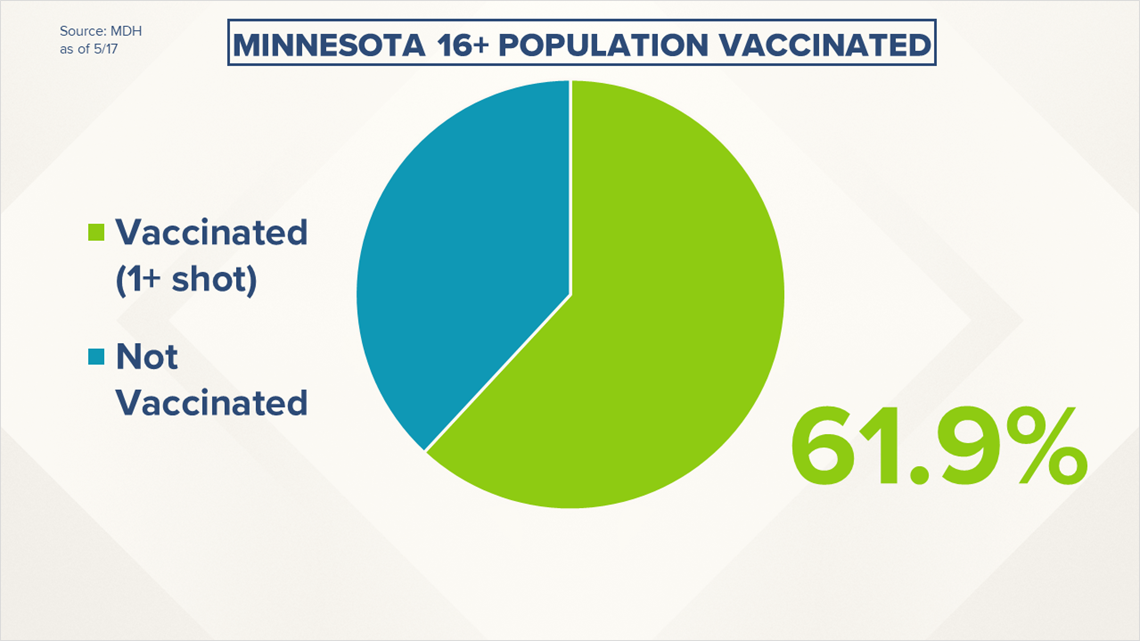
New daily infections are at 658 Wednesday, bringing the total number of reported cases to 596,186. Of those cases, 42,447 are based on antigen tests. Health professionals say a positive antigen test is considered a probable COVID case, while a positive PCR test is considered a confirmed case.
Young adults in the 20-24 age group make up the largest coronavirus case grouping with 57,662 cases and four deaths.
Hennepin County has recorded the most COVID activity with 123,262 cases and 1,738 deaths, followed by Ramsey County with 51,702 cases and 879 deaths, Dakota County with 46,159 cases and 454 deaths, and Anoka County with 42,021 cases and 441 deaths.

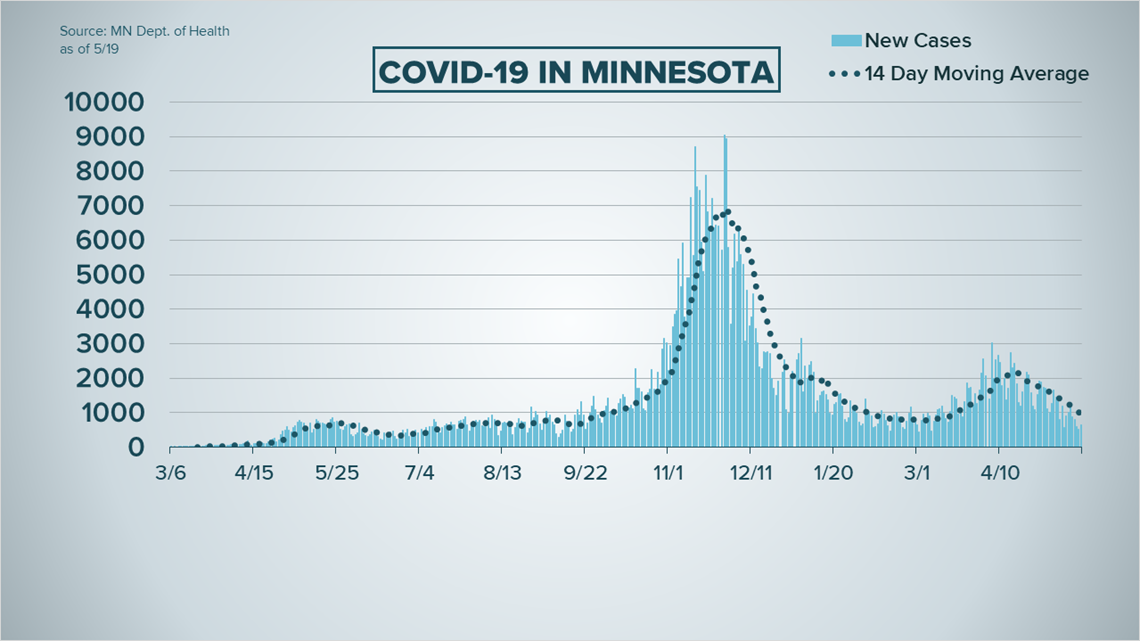
COVID hospitalizations remain steady with 420 people being treated for the virus on an inpatient basis as of Tuesday. Of those patients, 112 are being treated in ICU for more serious symptoms. Total hospitalizations are at 31,584 since the pandemic arrived in Minnesota.
MDH says 581,861 people who tested positive for COVID have now improved to the point they no longer require isolation.

